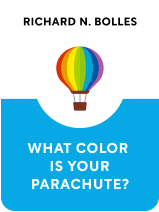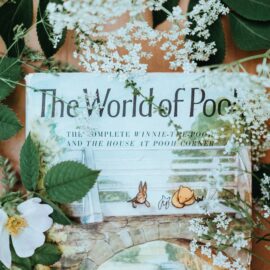

This article is an excerpt from the Shortform book guide to "What Color Is Your Parachute?" by Richard N. Bolles. Shortform has the world's best summaries and analyses of books you should be reading.
Like this article? Sign up for a free trial here .
What is the flower exercise from What Color Is Your Parachute? How do you complete the What Color Is Your Parachute flower exercise?
The What Color Is Your Parachute flower exercise is a self-evaluation on seven topics. You can use the completed “flower” to help evaluate your career or job prospects.
Read on for how to complete the What Color Is Your Parachute flower exercise.
The 7 Petals of the What Color Is Your Parachute Flower Exercise
The What Color Is Your Parachute flower exercise involves looking at yourself from seven different angles: compatibility with people, workplace conditions, skills, purpose, knowledges, money, and location. In the exercise, each angle will be visually represented by a flower petal. When you’ve finished the exercise, you’ll end up with a one-page What Color Is Your Parachute flower diagram of your flower that contains a visual summary of your personality as it relates to your career:
Petal #1: Compatibility With People
The goal of this petal is to figure out the kinds of people you like or don’t like working with, whether they’re people who work at your company or people you interact with as part of your job. This is important because the people around you either give you energy or drain it.
The entries on this petal will be a Holland Code (more on Holland typologies in worksheet #1) and a list of adjectives and/or Myers-Briggs typologies that describe people. Be specific with your entries. An example petal might read: Holland Code—RIS, polite, elderly, Myers Briggs ISTJ, detail-oriented, team players.
Petal #2: Workplace Conditions
The goal of this petal of the What Color Is Your Parachute flower exercise is to figure out what kind of conditions and locations you most prefer working in.
The entries on this petal will be a list of descriptions of your surroundings—physical surroundings only because you’ve already covered people surroundings in the first petal. An example petal might read: somewhere with lots of natural light, flexible hours, standing desks, a short commute, air conditioning.
Petal #3: Skills
The goal of this petal is to figure out what your favorite skills are. These skills should be transferable to any field and they’re probably related to your natural talents and abilities. However, while filling out this petal, it’s more important to list skills you love using than skills you’re good at.
The entries on this petal will be verbs or verbs accompanied by adverbs or objects. An example petal might read: write, mentor, accurately organize documents, teach children, speak, analyze, coach, edit, typeset, research.
Petal #4: Purpose
The goal of this petal is to figure out the mission or purpose of your life. You’ll consider your spiritual values and moral compass.
The entries on this petal will be a description of what facets of the world you want to improve and some details about those facets. Be specific. An example petal might read: improve the lives of children living in unsafe homes.
Petal #5: Knowledges
The goal of this petal is to figure out what knowledge you currently have that most excites you. If you like, you can also include a list of what you’d like to know. This will help you figure out what fields or industries you might like to work in.
The entries on this petal will be nouns. An example petal might read: how to change a tire, Japanese language, gardening, psychology, beekeeping.
Petal #6: Money
The goal of this petal of the What Color Is Your Parachute flower diagram is to determine how much money you need and/or want to earn from your job.
The entries on this petal will be the level you want to work at, a salary range, and benefits. An example petal might read: manager level, $30-35/hour, improve the environment.
Money and happiness are both important, and they’re related. A 2010 study found that people who made less money were unhappier than those who made more. However, it also found that once people made over $75K/year, their satisfaction with life increased, but their happiness remained the same. Therefore, this petal is extra-related to all the other petals, especially to ones that have to do with your happiness.
Petal #7: Location
The goal of this petal of the What Color Is Your Parachute flower diagram is to figure out where in the world you’d most like to live if you had the choice and to resolve any potential conflicts with your partner about where she’d like to live. It’s important to consider location early because if you get an unexpected opportunity, you want to be able to act on it right away.
The entries on this petal include five specific places to live and a list of five geographical factors. An example petal might read: Tokyo, Florence, Paris, Calgary, Buenos Aires, sunny, near mountains, good air quality, bilingual, friendly.
Conclusion
Now that you have either your own or a combined list of top factors, over the next ten days, ask everyone you meet if they know of anywhere in the world that has all, or at least most of the top, factors. You can also try the website Teleport to brainstorm, or if you really can’t decide or agree with your partner, throw darts at a map. Transfer the top five places and the top five factors to your petal diagram.
An Expanded What Color Is Your Parachute Flower Exercise: Rich Feller
Career professor Rich Feller put together his flower in 1982. He added four extra elements to his flower to make it more effective for himself—he keeps a regularly updated list of ten things he wants to 1) give, 2) do, 3) learn, and 4) have.

———End of Preview———
Like what you just read? Read the rest of the world's best book summary and analysis of Richard N. Bolles's "What Color Is Your Parachute?" at Shortform .
Here's what you'll find in our full What Color Is Your Parachute? summary :
- How to not just find a job, but find a job you love
- Why traditional resumes don’t find you the right job
- The 7 steps to identifying your ideal career






